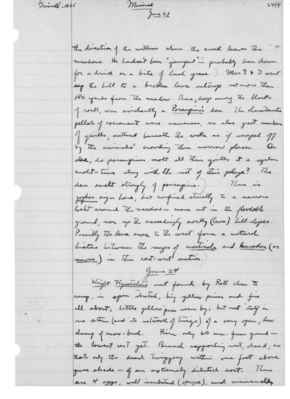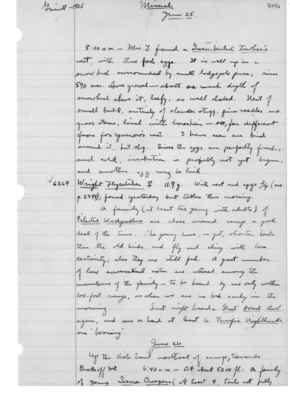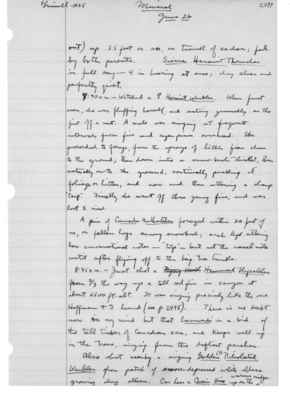Pages
S2 Page 40
Collector: Grinnell - 1925 Location: Mineral Date: June 23-24 Page Number: 2494
the direction of the willows where the creek leaves the meadows. He hadn't been "jumped" - probably been down for a drink or a bit of lush grass. Mrs. G. & I went up the hill to a broken lava outcrop not more than 150 yards from the meadow. There, deep among the blocks of rock, was evidently a Porcupine's den. The characteristic pellets of excrement were numerous, as also great numbers of quills, scattered beneath the rocks as if scraped off by the animals' crowding the narrow place. Or else, do porcupines molt all their quills at a regular molt-time along with the rest of their pelage? The den smelt strongly of porcupine. There is gopher sign here, but confined strictly to a narrow belt around the meadow - none out in the floodable ground, nor up in the exceedingly rocky (lava) hill-slopes. Possible the lava areas to the west form a natural hiatus between the ranges of monticola and leucodon (or navus) in this east-west section.
June 24 Wright Flycatcher's nest found by Rett close to camp, in open stretch, big yellow pines and firs all about; little yellow pines near by; but nest itself in one stem (and its network of twigs) of a very open, low clump of snow-bush. Rim only 6/0 mm. from ground the lowest nest yet. Branch supporting nest, dead; so that only the dead twiggery within one foot above gives shade - of an extremely diluted sort. There are 4 eggs, well incubated (opaque), and unusually
S2 Page 41
Collector: Grinnell - 1925 Location: Mineral Date: June 24 Page Number: 2495
in that each has scattering ^fine dots, mostly about the big end, of dark brown. The [female symbol] on the nest allowed me to get my hand within 2 feet of her, as I had an excellent view, proving her ^to be wrighti. Her tail is abnormal in that only two old feathers remain, the nest being new and only about 2/3 grown out. The nest is usual size and construction and nests chiefly within the forks of the main ceanothus stem which is 5/8 in. thick just below the forking. Taken nest + 3/4 + [female symbol] ^parent. 9 a.m.-- Mr. Hoffmann shot a (female) Three-Toed Woodpecker at 6:20 this morning out of a dead stub on ridge (Viola trail) hardly 10 minutes walk from camp, therefore not higher than 5200 ft.! 10:30 a.m. Hoffmann and I up Viola Trail at about 5500 ft. listening to Hammond (?) [sic] Flycatcher on chosen singing perch, which is very topmost snag-end of dead-topped fir. Estimated height from ground 135 feet. Bird plainly seen - breast to sun, appearing white. Bird continually shifts body, most frequently head, from side to side. Head thrown back with utterance of notes. Complete "song" has three elements: se-'put [uttered rapidly], taur-r-rp [roughly burred], tseep´ [rising inflection]. More of interval between first and second than second and third. Sometimes second and third interchanged. At camp - a Citellus douglasi, the first ground squirrel I have seen around Mineral, appeared on our "feeding log" this afternoon. It was a [female symbol] (teets showing) and she filled her cheek pouches bulgingly before she went off ^thru [sic] the snow-bush.
S2 Page 42
Collector: Grinnell - 1925 Location: Mineral Date: June 25 Page Number: 2496
8:00 a.m. - Mrs. G. found a Green-tailed Towhee's nest, with three fresh eggs. It is well up in a snow bush surrounded by small lodgepole pines; rim 590 mm. above ground - about as much depth of snowbush above it, leafy, so well shaded. Nest of small bulk, entirely of slender stuff, pine needles and grass stems, lined with horsehair - so, far different from fox sparrow's nest. I have seen one bird around it, but shy. Since the eggs are perfectly fresh, and cold, incubation is probably not yet begun, and another egg may be laid.
6264 Wright Flycatcher [female symbol] 11.9 g. With nest and eggs 3/4 (see p. 2494); found yesterday but taken this morning.
A family (at least two young with adults) of Pileated Woodpeckers are close around camp a good deal of the time. The young have, as yet, shorter tails than the old birds, and fly and cling with less certainty; also they are still fed. A great number of low conversational notes are uttered among the members of the family - to be heard by us only within 100-foot range, as when we are in bed early in the morning. Last night heard a Great Horned Owl again, and saw or heard at least 6 Pacific Nighthawks, one "booming".
June 26 Up the Vista Trail northeast of camp, towards Brokeoff Mt. 6:40 a.m. - At about 5200 ft.: A family of young Sierra Creepers (at least 4, tails not fully
S2 Page 43
Collector: Grinnell - 1925 Location: Mineral Date: June 26 Page Number: 2497
out) up 35 feet or so, on trunk of cedar; fed by both parents. Sierra Hermit Thrushes in full song - 4 in hearing at once, day clear and perfectly quiet.
7:40 a.m. - Watched a [female symbol] Hermit Warbler. When first seen, she was fluffing herself, and attacking generally as tho just off a nest. A male was singing at frequent intervals from fir and sugar pines overhead. She proceeded to forage, from the sprays of little fir close to the ground; then down into a snow-bush thicket, then actually on to the ground, continually picking at foliage or litter, and now and then uttering a sharp "tsip." Finally she went off thru young firs, and was lost to view.
A pair of Canada Nuthatches foraged within 20 feet of us, on fallen logs among snowbush; each kept uttering low conversational notes "Tiys" - but not the nasal note until after flying off to the big tree trunks.
8:45 a.m. - Just shot a Pygmy Nuth Hammond Flycatcher from 2/3 the way up a all red fir in canyon at about 6500 ft. alt. It was singing precisely like the one Hoffmann & I heard (see p. 2495). There is no doubt now in my mind but that hammondi is a bird of the tall timber of Canadian zone, and keeps well up in trees, singing from the loftiest perches.
Also shot a singing Golden ^(?) Pileolated Warbler from batch of snow-depressed white alders growing along the stream. Can hear a Cassin Vireo up on the ^warmer ridge.
S2 Page 44
Collector: Grinnell - 1925 Location: Mineral Date: June 26 Page Number: 2498
9:14 a.m. - Just flushed a [female symbol] Sierra Grouse from the trail, and then from the brush adjacent two young, well enuf feathered so that they flew strongly. The [female symbol] went up into a fir 25 feet or so, and did considerable clucking, and then a [male symbol] "boonted" from unknown distance and direction. Heard another female clucking (sympathetically?) about 50 yards down the slope. Brush here is chinquapin and snow-bush.
9:35 a.m. - Modoc Hairy Woodpecker nest, young just leaving (one caught) and [female symbol] parent frantic; lower lip of opening 3540 mm. above ground; in dead-hearted, otherwise living, lodgepole pine a foot in diameter at base growing with others around swale in ridge top - Arctostaphylos nevadensis all about. Old [female symbol] gives long series of loud chuckling notes, hoarse and coaxing; young one, now perching vertically against stem of little pine with head and neck stretched up straight and depressed against stem, keeping perfectly quiet. When routed out, young one gives loud "spink." This is at about 7000 ft. alt. Just shot a full-grown juvenal Lutescent Warbler from tip of lodgepole pines. It came with chickadees, Kinglets, and other birds that responded to the hubbub of the woodpeckers.
10:30 a.m. - Turned back and now close to where Hammond Flycatcher was shot, at 6500 ft. Just shot an Arctic Three-toed Woodpecker (male, with




